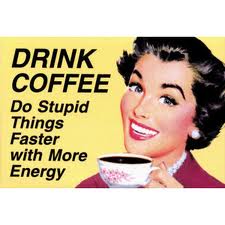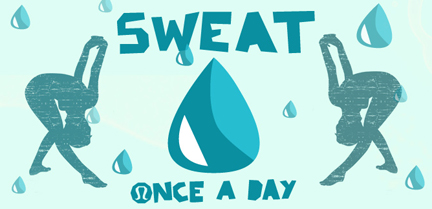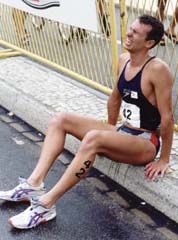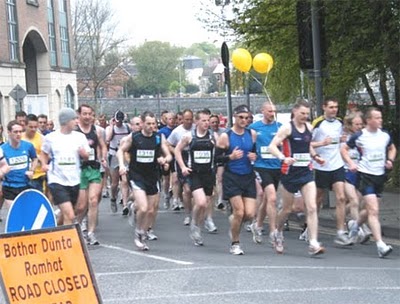With the 2012 edition of the Broad Street Run just days away, I figured it might be a good time to address any pressing questions ya'll might have. Kristen kicks it off with a good one...
The Feel Good Run
The Key To Marathon Success
If you're training for the Philly Marathon, then most likely you're in the midst of your heaviest training load right now. Putting the hay in the barn, as they say.

In only 2 weeks it really won't matter how much you train because the training window will have shut on your ability to build endurance for the race. At that point it's time to simply maintain intensity while cutting back on mileage and it's usually called “tapering” or “peaking”. This is one test you can't cram for!
Back to the present for a second, though. If you haven't already, it might be a good time to start thinking about your pacing strategy for the race. Most experienced marathoners will agree that this is usually the single biggest mistake made during a marathon. The consequences of poor pacing, which means running too fast in the early miles, include:
- Cramping
- Bonking (hitting the wall)
- Losing Good Running Form
- Definitely NOT hitting your goal time
Today we know not to blame the following factors on a lousy finish:
- Dehydration
- Electrolyte Imbalance (not enough salt)
It turns out dehydration and electrolyte imbalance are not the limiting factors they were once thought to be. As long as you drink to thirst you will most likely finish the race strong, given good pacing. Sure, you will finish the race LESS hydrated than when you started, but your performance will not decline because of it until you lose 2% or more of your bodyweight. So stop worrying about drinking at every single water station and start tuning in to your thirst mechanism. It's been refined for about a million years.
So it usually comes down to pacing and the question arises:
How do you know what pace to run?
The answer is that you will usually do well to base your pacing off of a recent race performance. A hard time trial or race within 6 weeks of your marathon will give you the most specific guidance when determining your optimal marathon race pace.
Plug your 5K to Half Marathon time into a running calculator to get the appropriate pace.
This is a pretty accurate way to figure out your pace, BUT... you must be specifically training hard for a marathon in order for this method to work. You can't just train 30 miles or run 5 hours per week and expect to run your best marathon.
Let me re-phrase that. Just because you ran a 5K last weekend in 22 minutes doesn't automatically mean you can go run a marathon in it's equivalent time of 3:34. Nope. 3:34 indicates your potential IF you are training optimally for the marathon.
In my experience, many people don't actually put in enough mileage to be optimally
trained. This is where the problem arises. People overestimate their fitness and go into the marathon with a bad pace strategy from the beginning.
In addition to an all-out race effort, one idea that's proved useful for my clients and I has been to run a 'race simulation'. This session, which tends to give you really valuable information and confidence, should be done about 3-4 weeks out from race day. About two easy days should precede the following session:
- Run Easy for 3 miles
- Run Marathon Goal Pace for 13 miles
- Run Easy for 2 miles
During and after the run you'll gain a sense for how strong you really are and if the pace seems reasonable.
Don't forget to take a gel every 35-40 minutes during the run. It is vital that you do ingest carbohydrate during the race – but that's a post for another day. Suffice it to say, you definitely want to practice this before race day as it appears that one can actually train the gut to absorb more calories than an 'untrained gut'.
So to summarize, the one thing you don't want to screw up is your pacing. Yes, it will take discipline and patience like I've said in the past. Expect it to feel easy – maybe even too easy – in the first 8-10 miles. That's perfect. You'll pass 'em all later!
PS: For those of you who have read this far and are running a marathon soon, you'll definitely want to check out coach Greg McMillan's marathon tips for pre- and post-race.
PPS: For a more comprehensive review on pacing, check out http://www.sportsscientists.com/2008/01/fatigue-examined.html
Remember Tangents?
As I cheered on many of my clients and friends at the Rock and Roll Philadelphia Half Marathon, I noticed something. In fact, it really puzzled me. With about 1/2 mile to go, most runners were (understandably) struggling to get to the finish line. The weird thing was, after running almost 13 miles all out, thousands runners were choosing to run farther than necessary!
Race Recap
Stifling sprint work.
Heavy deadlifting.
Clean nutrition (except for, like, 3 trips in 4 days to Ben & Jerry's while in Lake Placid, oops).
Constant hydration.
Good sleep habits (well, I tried).
Daily foam roller molestation...
I'm happy to report the past two months of training has paid off!
The USA Track & Field Masters National Championships were held in scenic Berea, Ohio (15mi southwest of Cleveland) on Sunday under bright sunshine and calm winds.
Coming into the race my personal best time for 1500m (a mile is 1609m) was 4:29.82 set on June 12 this year and, considering how well the past 6 weeks have gone, I set a goal of running 4:25. To do that, I'd need to really nail my pacing while expending as little energy as possible in the first 2 laps.
The tricky thing about these races is not knowing how everyone else will run. Ideally, in any race, you run directly behind someone for as long as possible before passing them. This produces a drafting effect that can save you a significant amount of energy. Would anyone run the pace that's right for me and do all the work for me?
For the first few laps that's exactly what happened. I tucked in behind a few guys and got off to a great start. My first and second laps were faster that any other race I'd ever run, but I was feeling strong and the drafting effect was working like a charm.
I sensed the guy in front of me starting to slow and, since I was still feeling 'good', decided to push on. I didn't have much of a chance of reeling in the top 3 runners - they were a bit out of my league - but I was on pace to get my goal time and wasn't about to let the opportunity slip away by staying comfortable.
The whole point of spending a summer weekend in, ahem, Berea, Ohio was to suffer for a little longer than 4 minutes. No coulda, shoulda or woulda!
As I rounded the last turn, the rather sparsely populated crowd began cheering louder and louder. Someone who I thought I'd left behind had started gaining on me. The thought of looking behind me never crossed my mind out of fear I wouldn't like what I'd see so I just tried my best to sprint as hard as I could for the finish line.
He couldn't quite catch me and I exceeded my goal!!! Ran 4:23.26 and totally surpassed my expectations!
Check out the vid here. The announcer kept misidentifying me as the leader in the first lap and a half which was actually kind of motivating!! And I'll be the first to admit that I need to work on holding form all the way to the line, but that is WAY easier said than done:-) In the moment, you're desperately trying to do whatever it takes...
The Single Best Thing You Can Do To Help Your Run
First off, thanks to those who commented on their experiences with changing their running form. I always find it helpful to listen to those who have had success as well as those who didn't. What obstacles came up? How did you overcome them? Check out the comments here. This week I want to fill you in on a secret. I really think it's THE easiest, simplest, and most effective way to fast track your training to a new level. In fact, if you wanted to improve your running performance and were only allowed to pick one of the following options, which would it be?
*High Tech Treadmill – maybe even an Alter-G!
*Idyllic setting of choice – mountains, beach, Forbidden Drive ;-)
*Unlimited shoes and apparel
*Altitude Tent
*Team or committed partner
*Doctor / Therapist on call
Now, to be sure, they will all help you to some degree. However, the one that sticks out in my mind is the phrase “team”. There are just so many good reasons to train with a team, club, or committed partner/friend.
 One of the reasons American elite distance running performance declined from the mid-1980s until recently was that runners began training alone. Prior to that time everyone trained in large groups. Once running became something one could pursue as a professional, runners figured they could more conveniently train on their own. They had a paycheck coming to them from their sponsor so why leave and train away from home?
One of the reasons American elite distance running performance declined from the mid-1980s until recently was that runners began training alone. Prior to that time everyone trained in large groups. Once running became something one could pursue as a professional, runners figured they could more conveniently train on their own. They had a paycheck coming to them from their sponsor so why leave and train away from home?
GETS RESULTS
People like to think Kenyans are genetically different. But people who think along those lines are the same people who like to blame others for their life predicaments, too. Rather, Kenyans have always trained in groups – huge groups. Plus, running is seen as a way out of poverty and so motivation is extremely high.
You combine high motivation with others who have the same mind set and you will get some extremely powerful results. Can you think of any examples in your life where you accomplished more than you thought you could simply because you worked with a group?
CAMARADERIE
When I show up at road races or track meets and I see people wearing the same racing singlet there's an instant bond. Like, “we're in this together”. Running for your team provides a whole other layer of motivation because you want to do well for the team. Plus, it's great to connect with like-minded people who share the same passion. As a member of the Greater Philadelphia Track Club I've shared in some incredible experiences that wouldn't have been possible otherwise, like running in the Penn Relays and watching teammates set a world record in the Masters 4X800m!
IT'S FUN!
Perhaps one of my favorite aspects of training with a friend is the social aspect. My buddy and I lead busy lives and the great thing about running is that we can catch up WHILE getting fit at the same time. Amazing! Love those time efficient activities...
NO EXCUSES
I think most of us can agree that meeting someone else for a workout provides just the right amount of accountability that we need to stay on track. We are easier on ourselves if we skip a workout, but feel terrible if we let someone else down. Interesting? Before you know it, you'll have strung multiple weeks of solid training together simply because you were held accountable by each other.
CONFIDENCE
If you see your friend improving and you're running the same workouts, you should expect to improve as well. If I can keep up with my workout partner during a set of intervals, I should feel confident that I can run with him during a race.
Your confidence will also improve in another critical area: training decisions. Not sure which shoes are right? Not sure what type of run is best for your goals? Not sure which Body Glide product works best? Wouldn't it be nice to ask your friends? They'll give you confidence that you're doing all the right things. Now, admittedly this can go both ways. You could also be so inspired or competitive that you do too much, too soon, but hopefully as an intelligent reader of this blog you'll avoid that pitfall.
STRENGTHS and WEAKNESSES
I actively seek out workout friends who are faster than me because it helps me raise my game. Ever notice you play to the level of your competition? I tend to have better speed than endurance. So, as much as it hurts to run with my endurance endowed friends, I've improved dramatically because of it. Same goes for them. They'd NEVER do any sprinting if it wasn't for me!
 The bottom line is this: if you're not training with friends, a team, or a club at least some of the time, you are missing out big time. You'll get faster, save time, make new friends, build confidence, have no excuses and, most of all, enjoy your training. Come join us at Lululemon on Walnut Street every Thursday at 6pm for a taste of the good life!
The bottom line is this: if you're not training with friends, a team, or a club at least some of the time, you are missing out big time. You'll get faster, save time, make new friends, build confidence, have no excuses and, most of all, enjoy your training. Come join us at Lululemon on Walnut Street every Thursday at 6pm for a taste of the good life!




